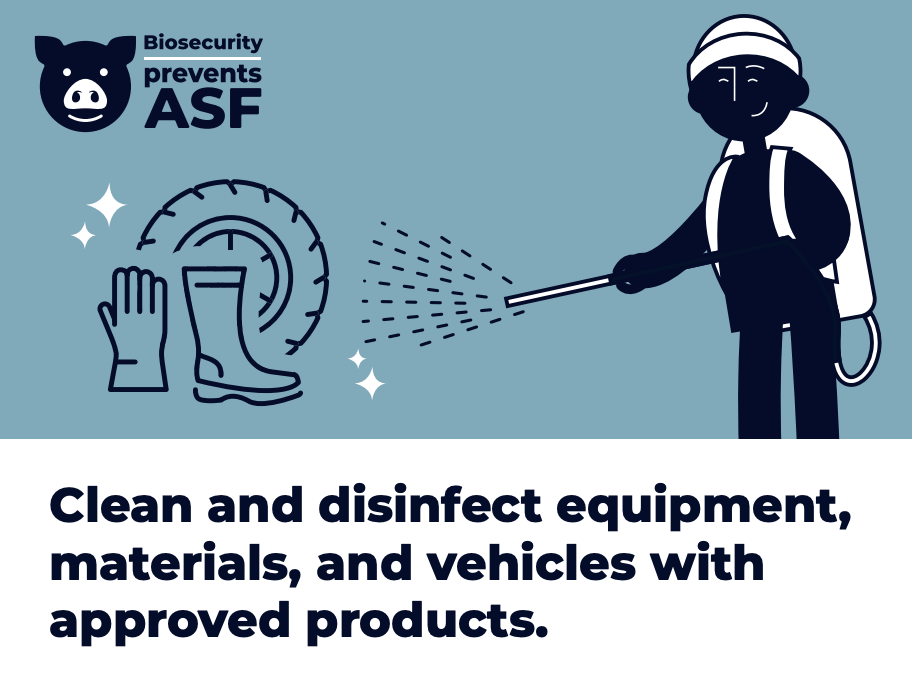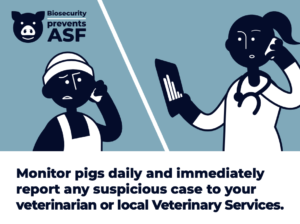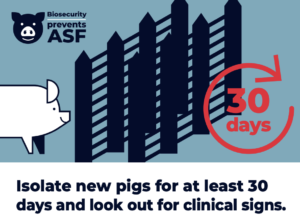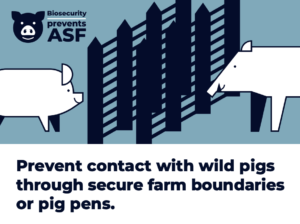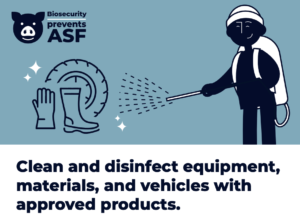FAQ on African Swine Fever (ASF)
What is ASF?
African swine fever is a highly contagious haemorrhagic viral disease of domestic and wild pigs, responsible for serious production and economic losses due to its high mortality rate and the control measures implemented by affected countries. It is caused by a DNA virus of the Asfarviridae family.
Although signs of ASF and classical swine fever (CSF) may be similar, the ASF virus is unrelated to the CSF virus.
ASF does not affect human health.
What are the clinical signs of ASF?
Clinical signs and mortality rates can vary according to the virulence of the virus and the type/species of pig:
Acute forms are characterised by high fever, depression, anorexia and loss of appetite, haemorrhages in the skin (redness of skin on ears, abdomen and legs), abortion in pregnant sows, cyanosis, vomiting, diarrhea and death within 6-13 days (or up to 20 days). Mortality rates may be as high as 100%.
Subacute and chronic forms are caused by moderately or low virulent viruses, which produce less intense clinical signs that can be expressed for much longer periods. Mortality rates are lower but can still range from 30-70%. Chronic disease symptoms include weight loss, intermittent fever, respiratory signs, chronic skin ulcers and arthritis.
Different types of pig may have varying susceptibility to ASF virus infection. African wild suids may be infected without showing clinical signs, allowing them to act as reservoirs.
Where does ASF come from?
African swine fever has traditionally been present in Africa, until 1978 when the disease was introduced to the Italian island of Sardinia. In 2007, the disease was confirmed in the Caucasus region of Georgia and, from there, the ASF virus gradually spread to neighbouring countries affecting domestic pigs and wild boar.
The first occurrence of ASF in the European Union (EU) was reported in 2014 and since then, numerous EU countries have been affected by this devastating pig disease. Yet, two European countries have also managed to eradicate it:
Belgium (March 2020) and Czech Republic (April 2018).
In 2018, the virus leapt to China (People’s Rep. of), representing the first occurrence of ASF in Asia. Since then, the disease has continued to spread in this region and in Oceania.
In July 2021, the disease reappeared in the Americas after an absence of almost 40 years, having been introduced in Dominican Republic and later in Haiti.
How does ASF spread?
The epidemiology of ASF is complex and varies depending on the environment, types of pig production systems, the presence or absence of competent tick vectors, human behaviour, and the presence or absence of wild pigs.
Routes of transmission can include:
– direct contact between infected pigs, domestic or wild;
– ingestion of material contaminated with the virus (e.g. food waste, feed, or garbage);
– contact with contaminated fomites (such as clothing, footwear or vehicles), or
– bite of biological vectors (soft ticks of the genus Ornithodoros), where present.
How is ASF diagnosed?
African swine fever may be suspected based on clinical signs, but confirmation must be made with laboratory tests, particularly to differentiate it from classical swine fever (CSF).
Is there a cure for ASF?
Despite several research studies are ongoing, currently there is no effective treatment nor vaccine against ASF.
Any type of ‘ASF vaccine’ sold on markets is fake. As these are illegally manufactured, they are not subject to the usual vaccine evaluation protocols and may contain poorly attenuated strains of the virus, which poses serious safety risks and have the potential to spread between pigs, resulting in chronic forms of the disease.
Can humans get ASF?
ASF is not a risk to human health.
It is safe to eat pork?
Humans do not get sick from African swine fever. The disease cannot be transmitted to humans through contact with pigs or by consuming pork products. However, meat contaminated with the ASF virus should not be used to feed pigs, as pigs can get infected this way. It is therefore recommended to avoid feeding pigs with food scraps or kitchen waste that have not been properly treated.
Should cases of ASF be notified to the WOAH?
ASF is a WOAH-listed disease. It is therefore mandatory for national Veterinary Authorities to notify WOAH of any ASF case in a timely manner. At the same time, countries may also self-declare the absence of ASF from their territory on a voluntary basis.
Maintaining transparency on the global situation of African swine fever is key to facilitate the implementation of early measures that could halt the spread of the disease.
How can we prevent ASF?
Biosecurity is the most important and effective measure available to prevent and control African swine fever. Rigorous and continuous implementation of biosecurity principles at farm level, as well as increasing vigilance at borders to prevent the illegal movement of ASF-infected animals or commodities, can halt the virus from entering pig herds.
It is equally important that all those who might be involved in the direct and indirect transmission of ASF are made aware and acknowledge the importance and potential consequences of their actions. In this scenario, efficient risk communication becomes also an essential component of the disease prevention efforts. To support countries, WOAH, jointly with the Food and Agriculture Organization of the United Nations (FAO), has developed an awareness campaign that targets different actors who are susceptible to play a role in the spread of the disease. Hunters, small pig farmers and large commercial pig producers, as well as travellers and the transport industry, are called upon to be actively engaged in curbing the spread of this deadly pig disease.
Can African swine fever be controlled?
Despite the complexity and challenging characteristics of ASF, its global control is possible with sustained effort and collaboration at national, regional and international levels. For this reason, in 2020, WOAH launched the Initiative for the Global Control of ASF in partnership with the Food and Agriculture Organization (FAO), under the umbrella of the Global Framework for the Progressive Control of Transboundary Animal Diseases (GF-TADs). Its goal: bringing together governments, industry and experts to support our Members in their effort to control this devastating pig disease.
What are the WOAH’s goals regarding ASF control?
To achieve global control, ASF requires adequate risk management through the development and implementation of national control programmes. Through the Initiative for the Global Control of ASF, WOAH and FAO aim to improve the capability of countries to prevent, respond to and eradicate the disease using WOAH International Standards and best practices that are based on the latest science available. The goal is also to establish an effective coordination and cooperation framework for the control of ASF at global, regional and local level and to facilitate business continuity while ensuring safe production and trade to protect food systems.
Prevention is essential
In the absence of an effective vaccine, prevention in ASF-free countries depends on implementation of appropriate import policies and biosecurity measures, ensuring that neither infected live pigs nor pork products are introduced into ASF-free areas.
This includes ensuring proper treatment and disposal of waste food from aircraft, ships or vehicles coming from affected countries and policing illegal imports of live pigs and pork products from affected countries.
At farm level, the following key biosecurity principles should be implemented to keep animals healthy.
Control measures to halt ASF spread
During outbreaks and in affected countries, controlling the spread of African swine fever can be difficult and must be adapted to the specific epidemiological situation.
General sanitary measures that may be implemented include:
- early detection and humane killing of animals (with proper disposal of carcasses and waste),
- thorough cleansing and disinfection,
- zoning/compartmentalisation and movement controls,
- surveillance and detailed epidemiological investigation, and
- strict biosecurity measures on farms.
As observed in Europe and in some regions of Asia, where wild boar play a significant role in the transmission of ASF, the management of this wild population density and their interaction with low-biosecurity pig production systems is key. The good knowledge and management of the wild boar population and a good coordination among the Veterinary Services, wildlife and forestry authorities are required to successfully prevent and control ASF.
SOURCE- https://www.woah.org/en/disease/african-swine-fever
PHOTO -CREDIT-World Organisation for Animal Health (WOAH)



